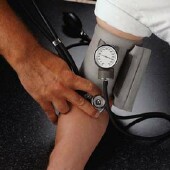 |
 |
 |

High Blood Pressure Stalks Many Americans
Seven in 10 don't do enough to protect themselves from stroke, heart attack|
|
HealthDay
Friday, November 21, 2008
 FRIDAY, Nov. 21 (HealthDay News) -- It's one of medicine's mantras: If you have high blood pressure, taking steps to lower it will have a dramatic impact on your risk of stroke, heart disease and more.
FRIDAY, Nov. 21 (HealthDay News) -- It's one of medicine's mantras: If you have high blood pressure, taking steps to lower it will have a dramatic impact on your risk of stroke, heart disease and more.
But 70 percent of people with high blood pressure still aren't doing a good enough job controlling it, according to a U.S. Centers for Disease Control and Prevention study.
"High blood pressure is clearly associated with stroke, and it's a very preventable and treatable condition, but a lot of people still aren't doing what they should," said Dr. Keith Siller, medical director of the Comprehensive Stroke Care Center at New York University Langone Medical Center in New York City.
Almost one in three American adults has high blood pressure, which is also known as hypertension. Blood pressure is a measurement of the force exerted when the heart is beating (systolic pressure) or when the heart is at rest (diastolic pressure). Systolic is the top number and diastolic is the bottom number on a blood pressure reading.
A reading above 140/90 mmHg is considered high blood pressure, and anything between 120/80 mmHg and 139/89 mmHg is considered prehypertension, according to the U.S. National Heart, Lung, and Blood Institute. A reading below 120/80 mmHg is considered normal.
Diet, exercise, and blood-pressure lowering medications are all mainstays of blood pressure management. Many people have to take a combination of medications to properly control their blood pressure.
To assess what measures those who've been diagnosed with hypertension are taking to control their high blood pressure, government researchers interviewed almost 25,000 Americans with high blood pressure. Almost all -- 98 percent -- said they were doing at least one thing to try to lower their blood pressure.
Most also said they were taking some or all of the commonly recommended measures to control blood pressure. For example:
- 71 percent said they had changed their eating habits.
- 80 percent were limiting or eliminating the use of salt.
- 80 percent said they'd reduced alcohol consumption or abstained from drinking alcohol.
- 69 percent said they exercised.
- 73 percent were taking high blood pressure medications.
Despite these measures, just 30 percent of Americans with high blood pressure have it under control, according to the study, which was published in a recent issue of the CDC's journal, Morbidity and Mortality Weekly Report.
"The single most important thing people can do to prevent stroke is to manage their modifiable risk factors," said Dr. Bruce Silverman, a neurologist at Providence Hospital and Medical Centers in Southfield, Mich. "That means controlling blood pressure, quitting smoking, controlling blood sugar if you're diabetic, managing stress, exercising regularly, and watching your diet."
"There are so many risk factors you can't do anything about, like age or gender, but you can do something about your blood pressure, weight and stress levels, and it will significantly impact your risk of stroke," he added.
Both experts said that home monitoring of your blood pressure can help, and if your readings are consistently high, you should let your doctor know.
"People get frustrated when they're taking a medication as they should, and they still have a high blood pressure reading," Siller said. "But, sometimes it's not enough medication, or you may need more than one medication to really get your blood pressure under control."
Silverman also pointed out that "it's not about taking the medicine and hoping it goes away. Lifestyle and behavioral changes are still important. And, if you can control your weight, quit smoking, and exercise, you can make a big dent in high blood pressure on your own."
HealthDay
Copyright (c) 2008 ScoutNews, LLC. All rights reserved.
Related News:
More News on this Date
Related MedlinePlus Pages:
| Home | Health Topics | Drugs & Supplements | Encyclopedia | Dictionary | News | Directories | Other Resources | |
| Disclaimers | Copyright | Privacy | Accessibility | Quality Guidelines U.S. National Library of Medicine, 8600 Rockville Pike, Bethesda, MD 20894 National Institutes of Health | Department of Health & Human Services |
Date last updated: 24 November 2008 |




